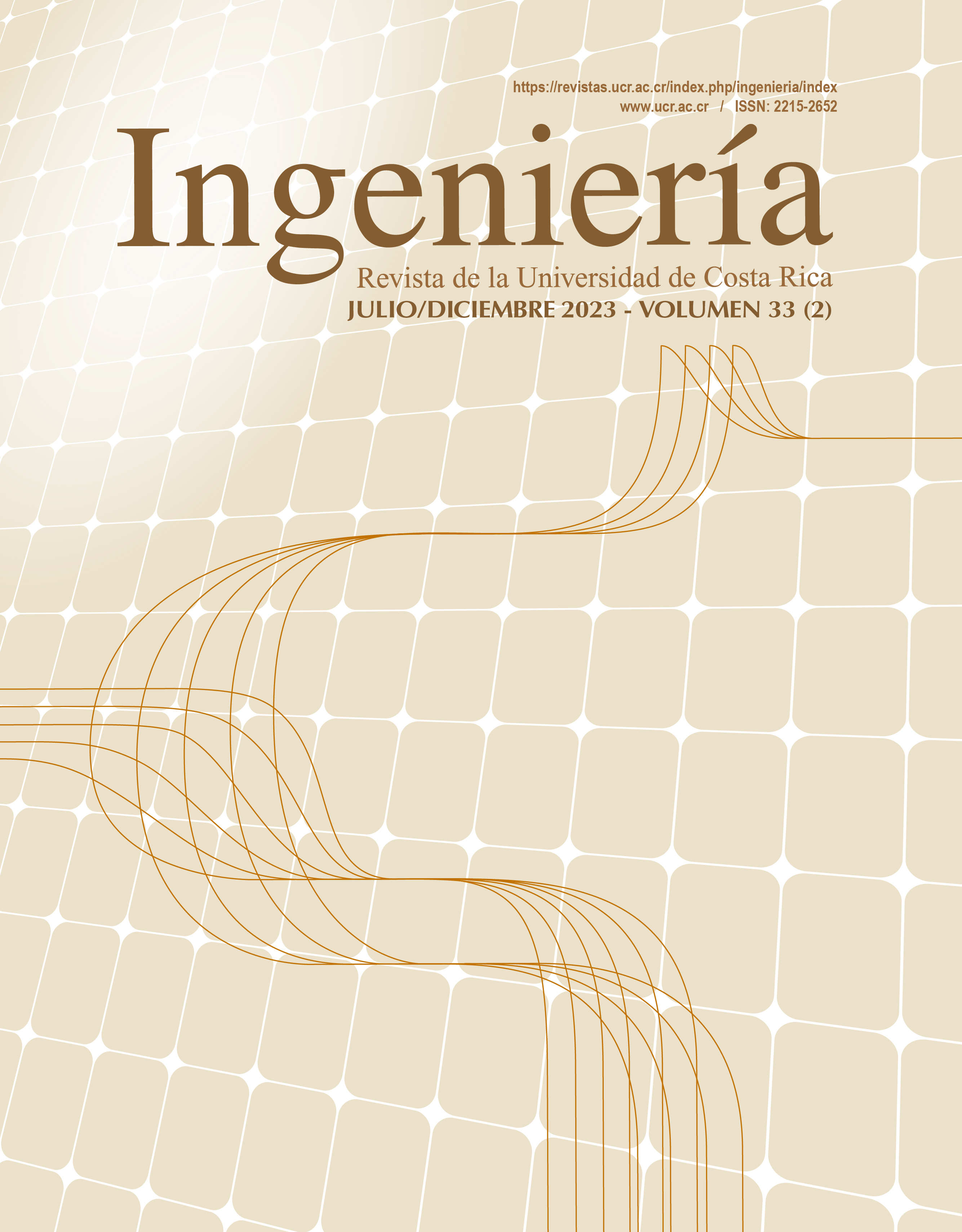Resumen
Las bases de datos de oleaje, a partir de mediciones de campo, son información relevante y de alto impacto para las ciencias marinas y la ingeniería. Este trabajo compiló las diferentes bases de datos de oleaje medidas en campo en Costa Rica, con el fin de preservar en una única fuente de consulta dicha información; a su vez, se compararon dichos datos con los ofrecidos por el reanálisis WAVERYS del Copernicus Marine Enviroment Monitoring Service, con el propósito de analizar esta información y su posible utilización en futuras investigaciones en el país y en la región. Se recopilaron los datos históricos empleados en distintos proyectos y registrados por diferentes instituciones del Estado. Los datos fueron analizados espacial y temporalmente por métodos estadísticos, se realizaron comparaciones entre los distintos registros y la base de datos de reanálisis de oleaje WAVERYS. Los resultados mostraron que en el Caribe se tienen registros de oleaje entre los años 2015 y 2017. En el Pacífico se cuenta con datos que se midieron durante la construcción de Puerto Caldera (1978-1985); además, existen datos de campañas de campo realizadas en distintos lugares entre los años 2009 y 2011, y los datos medidos por una red de equipos de oleaje colocados en zonas costeras desde el 2014 hasta la actualidad. Finalmente, se verificó que los datos del reanálisis tienen un alto potencial de aplicación, en las ciencias marinas y la ingeniería de costas, en esta región del globo.
Citas
C. Jaramillo, M. S. Jara, M. González and R. Medina, “A shoreline evolution model considering the temporal variability of the beach profile sediment volume (sediment gain/loss),” Coast. Eng., vol. 156, pp. 103612, March, 2020, doi: https://doi.org/10.1016/j.coastaleng.2019.103612.
E. Ramos et al, “Coastal waters classification based on physical attributes along the NE Atlantic region. An approach for rocky macroalgae potential distribution,” Estuar. Coast. Shelf Sci., vol. 112, pp. 105-114, Oct., 2012, doi: http://dx.doi.org/10.1016/j.ecss.2011.11.041.
F. Calleja, G. J. Chacón and H. Alfaro, “Marine aquaculture in the pacific coast of Costa Rica: Identifying the optimum areas for a sustainable development,” Ocean. Coast. Manag., vol. 219, pp. 106033, March, 2022, doi: https://doi.org/10.1016/j.ocecoaman.2022.106033.
B. Gouldby, F. J. Méndez, Y. Guanche, A. Rueda and R. Mínguez, “A methodology for deriving extreme nearshore sea conditions for structural design and flood risk analysis,” Coast. Eng., vol. 88, pp. 15-25, June, 2014, doi: https://doi.org/10.1016/j.coastaleng.2014.01.012
T. Albers and K. Schmitt, “Dyke design, floodplain restoration and mangrove co-management as parts of an area coastal protection strategy for the mud coasts of the Mekong Delta, Vietnam,” Wetlands Ecol. Manage., vol. 23, no. 6, pp. 991-1004, Jul., 2015, doi: https://doi.org/10.1007/s11273-015-9441-3.
P. Li, O. M. Faltinsen and M. Greco, “Wave-Induced Accelerations of a Fish-Farm Elastic Floater: Experimental and Numerical Studies,” J. Offshore Mech. Arct. Eng., vol. 140, no 1, pp. 011201, Feb., 2018, doi: https://doi.org/10.1115/1.4037488.
JICA, Japan International Cooperation Agency, “Final Report. The Study on the Maintenance Project of the Port of Caldera in the Republic of Costa Rica,” Ministerio de Obras Públicas y Transportes, San José, Costa Rica, 1986.
Watermark, “Consultoría para la medición y calibración del oleaje en la costa pacífica de Costa Rica,” Instituto Costarricense de Turismo, San José, Costa Rica, 2010.
Baird and CH2M HILL, “Meteorological and Oceanographic Report,” APM Terminals, San José, Costa Rica 2013.
H. Tolman and D. Chalikov, “Source Terms in a Third-Generation Wind Wave Model,” J. Phys. Oceanogr., vol. 26, no. 11, pp. 2497-2518, 1996, doi: https://doi.org/10.1175/1520-0485(1996)026<2497:STIATG>2.0.CO;2.
J. Pérez, M. Menéndez and I. J. Losada, “GOW2: A global wave hindcast for coastal applications,” Coast. Eng., vol. 124, pp. 1-11, Jun., 2017, doi: http://doi.org/10.1016/j.coastaleng.2017.03.005.
S. Law-Chune, L. Aouf, A. Dalphinet, B. Levier, Y. Drillet and M. Drevillon, “WAVERYS: a CMEMS global wave reanalysis during the altimetry period,” Ocean Dyn., vol. 71, pp. 357-378, Jan., 2021, doi: https://doi.org/10.1007/s10236-020-01433-w.
C. Izaguirr, F. J. Méndez, M. Menéndez and I. J. Losada, “Global extreme wave height variability based on satellite data,” Geophys. Res. Lett., vol. 38, no. 10, pp. L106007, May, 2011, doi: https://doi.org/10.1029/2011GL047302.
L. Aouf, D. Hauser, C. Tison and B. Chapron, “On the assimilation of multi-source of directional wave spectra from Sentinel 1A and 1B, and COSAT in the wave model MFWAM: Toward an operational use in CMEMS-MFC,” presented at International Geoscience and Remote Sensing Symposium Conference, Valencia, Spain, Jul. 22-27, 2018.
ERA5-Land hourly data from 1950 to present. Copernicus Climate Change Service (C3S) Climate Data Store (CDS), Copernicus Climate Change Service (C3S), 2022, doi: 10.24381/cds.e2161bac.
European Centre for Medium-Range Weather Forecasts. Part VII: ECMWF Wave Model. (2013). Accessed: 2022. [Online]. Available : https://www.ecmwf.int/sites/default/files/elibrary/2013/9248-part-vii-ecmwf-wave-model.pdf
Copernicus Marine Environment Monitoring Service. GLOBAL_REANALYSIS_WAV_001_032. (2021). Accessed: 2022. [Online]. Available : https://catalogue.marine.copernicus.eu/documents/QUID/CMEMS-GLO-QUID-001-032.pdf
Y. Goda, “Analysis of wave grouping and spectra of long-travelled swell,” Rep. Port and Harbour Res. Inst., vol. 22, no. 1, pp. 3-41, 1983.
R. E. Mora-Escalante and J. P. Ureña-Mora, “Numerical simulation of wave field around Cocos Island, Costa Rica,” Rev. Biol. Trop., vol. 68, no. 1, pp. 198-212, Mar., 2020, doi: https://doi.org/10.15517/rbt.v68iS1.41181.
V. Magaña, J. A. Amador and S. Medina, “The midsummer drought over Mexico and Central America”, J. Clim., vol. 12, no. 6, pp. 1577-1588, Jun., 1999, doi: https://doi.org/10.1175/1520-0442(1999)012<1577:TMDOMA>2.0.CO;2.
Comentarios

Esta obra está bajo una licencia internacional Creative Commons Atribución-NoComercial-CompartirIgual 4.0.
Derechos de autor 2023 Henry Alfaro Chavarría, Javier Zumbado González, Rodney Mora Escalante, Felipe Calleja Apéstegui, Georges Govaere Vicarioli



